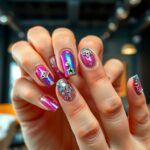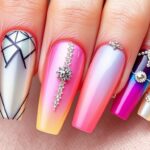Looking to elevate your nail game? We’ve gathered the most stunning nail ideas tutorials that’ll transform your manicure from basic to breathtaking. Whether you’re a complete beginner or someone who’s been painting nails for years, our step-by-step guides make creating salon-worthy designs at home incredibly simple.
We understand that finding the right nail tutorial can be overwhelming with countless options online. That’s why we’ve curated only the trendiest, most practical tutorials that use accessible tools and techniques. From elegant French tips to eye-catching geometric patterns, our collection covers everything you’ll need to express your unique style through your fingertips.
15 Stunning Nail Ideas Tutorials for Every Skill Level
- Classic French Tips with a Twist: Create elegant French tips by applying a nude base coat and letting it dry completely. Next, use nail guides to paint perfect white tips, then add a thin line of glitter or metallic polish between the nude and white sections for that modern twist. Finish with a top coat for lasting shine.
- Minimalist Geometric Patterns: Start with a solid base color and allow it to dry thoroughly. Using a thin brush, create simple geometric shapes like triangles or lines with contrasting colors. These designs work beautifully on accent nails for those just beginning their nail art journey.
- Marble Effect Nails: Achieve stunning marble nails by dropping dots of different colored polishes into a small container of room temperature water. Swirl the colors with a toothpick to create a marble pattern, then dip your finger in and lift slowly. Clean excess polish from around your nail for professional-looking marble effect.
- Gradient Ombré Nails: Apply a light base color and let dry completely. Place a small amount of your second color on a makeup sponge alongside the base color, slightly overlapping them. Dab the sponge onto nails to create a beautiful gradient effect, repeating until you reach desired intensity.
- Floral Accent Nails: Paint all nails with a solid base color, then select one or two accent nails. Using a dotting tool, create flower centers on your accent nails, followed by petals using a thin brush. Flowers can be as simple or detailed as your skill level allows.
- Glitter Dip Design: Apply a base coat and let dry. Brush nail glue on areas where you want glitter, then dip your nail into fine glitter powder. Tap off excess and seal with a top coat for a dazzling accent that catches the light beautifully.
- Negative Space Designs: Leave portions of your nail unpainted while applying polish to create geometric or abstract shapes. This technique creates a modern, minimalist look that’s surprisingly easy to achieve with tape guides or nail stencils.
- Water Decal Application: Purchase nail water decals in designs you love, then cut them to fit your nail size. Soak in water for 10-20 seconds until the decal slides off the backing paper, position on your nail, and gently press out any bubbles before sealing with top coat.
- Polka Dot Patterns: Create perfect polka dots by dipping a dotting tool (or bobby pin) into polish and pressing onto nails in patterns. Vary the dot sizes and colors for more visual interest, starting with larger dots and adding smaller ones once dried.
- Stamping Technique: Purchase a nail stamping kit with plates featuring your favorite designs. Apply polish to the plate, scrape off excess, pick up design with stamper, and press onto your nail for instant professional-looking art.
- Easy Striping Tape Design: Apply a base color and let dry completely. Place thin striping tape in desired patterns on your nail, apply a second color over entire nail, and carefully remove tape while polish is still wet to reveal clean lines underneath.
- Foil Transfer Nails: Apply a sticky base coat or nail glue and let it become tacky. Press nail foil (shiny side up) firmly onto the tacky surface, then peel back to transfer the metallic finish to your nail. Seal with top coat for a long-lasting metallic effect.
- Stained Glass Effect: Paint your nails black and let dry. Apply different colored polishes in sections, leaving thin black lines between colors to create a stunning stained glass window effect. Finish with a glossy top coat to enhance the glass-like appearance.
- Newspaper Print Transfer: Paint nails with a light-colored base and let dry completely. Dip each nail in alcohol for 5-10 seconds, press a newspaper clipping onto the nail, hold for 30 seconds, and peel away to reveal text transferred onto your nail. Seal with top coat.
- Textured 3D Nail Art: Create dimensional designs by mixing a small amount of acrylic powder with clear polish to form a moldable paste. Apply this mixture to create raised patterns or flowers on your nails using a thin brush. Allow to dry completely before sealing with a generous layer of top coat.
Essential Tools and Supplies for Nail Art Beginners

Now that you’re inspired by our nail tutorials, it’s time to gather the essential tools and supplies to bring these designs to life. Creating beautiful nail art starts with having the right equipment at your fingertips.
Must-Have Base Products
- Quality Nail Polishes form the foundation of any nail art collection. Start with versatile colors that can work across multiple designs before expanding your palette.
- Cuticle Oil keeps your nail beds healthy and moisturized, which is crucial for professional-looking results and overall nail health.
- Nail Files in Various Grits (240, 180, and 120) allow you to shape and prep nails properly before applying any art or polish.
- Hand Sanitizer maintains hygiene throughout your nail application process, preventing contamination and ensuring best results.
- Base and Top Coats protect your natural nails while extending the life of your nail art creations.
Nail Art Tools Worth Investing In
- Dotting Tools come in different sizes and are essential for creating precise dots and starting most nail designs. These simple tools open endless possibilities for patterns and details.
- Quality Nail Art Brushes including detail brushes and clean-up brushes make all the difference in achieving professional-looking designs. Pair them with a dappen dish for cleaning polish edges and brushes.
- Rhinestones, Bullion, and Caviar Beads add dimension and sparkle to your designs. Orangewood sticks or toothpicks help with precise placement of these tiny embellishments.
- Sanding Bands and E-files with appropriate drill bits make nail prep more efficient, especially when working with acrylic or gel extensions.
- Nail Art Stickers and Striping Tape offer quick answers for intricate designs when you’re short on time or building your skills.
- Stamping Plates and Stampers allow you to transfer complex patterns onto your nails with minimal effort, perfect for consistent results.
- Loose Glitter creates stunning sparkly effects that transform simple manicures into eye-catching designs.
- Nail Training Hand provides the perfect practice surface to hone your skills before working on real nails, making it invaluable for beginners.
Simple French Manicure Tutorials for Elegant Nails

The French manicure remains one of the most sophisticated nail styles that never goes out of fashion. This timeless look involves painting the tips of your nails white while keeping the rest of the nail in a neutral shade, typically pale pink or beige.
Classic French Tip Techniques
Creating the perfect classic French tip requires precision and patience. Start by prepping your nails through cleaning and shaping them to your desired length and form. Apply a quality base coat to protect your natural nails from staining and create a smooth surface for polish application. Next, paint the entire nail with a neutral pink or beige shade and allow it to dry completely. For that signature crisp line between colors, use nail guides or stickers placed just below where you want your white tip to end. Apply a thin layer of white polish to the tips, ensuring they’re symmetrical and evenly spaced on each nail. Remove the guides while the polish is still slightly wet for the cleanest edge. Finish with a glossy top coat to seal your design and add shine that makes your French manicure look professional and elegant.
Modern Twist on French Manicures
Traditional French manicures have evolved into creative variations that offer fresh takes on this classic style. Color variations provide an exciting alternative to the standard white tips, allowing you to experiment with pastels, metallics, or bold hues that complement your outfit or mood. Try diagonal or curved tips by painting the white portion at an angle or in a curved shape for a contemporary appearance that draws attention. Add personality with nail art additions such as tiny stripes, dots, or patterns applied to either the tips or the base of your nails. Create a stunning ombre effect by gradually blending the color from the tip to the base, resulting in a soft, sophisticated look. For more dramatic results, gel or acrylic extensions can be used to extend the nail and create more pronounced French tip designs. Popular resources for learning these techniques include YouTube channels like “cutepolish” and Pinterest boards such as “Step-by-Step Nail Art Tutorials” by Tammy Taylor, which showcase many creative approaches to this enduring manicure style.
Easy Gradient Nail Art Tutorials for Beginners

Sponge Gradient Method
Creating gorgeous gradient nails doesn’t require professional skills, and the sponge method is perfect for beginners. Start by applying a base coat, preferably the lightest shade in your gradient scheme or a white polish to make bright colors pop. Next, prepare a makeup foundation sponge by cutting it to your desired shape for easier application. When applying the gradient, dab the sponge into all your chosen polish colors, then press it onto your nail starting from the cuticle, placing the darkest color nearest to the cuticle and the lightest toward the middle. Build up the effect by applying thin layers until you achieve your desired opacity, making sure each layer dries completely before adding another. Finish your gradient masterpiece with a quick-dry top coat to seal the design and add brilliant shine.
Brushed Gradient Technique
The brushed gradient technique offers another approachable method for beginners wanting to create stunning ombré effects. Begin with applying a base coat that matches your lightest gradient shade or use white polish as your canvas. For a simple longitudinal gradient, apply one color on one half of the nail and another color on the remaining half, then use a brush to blend where the colors meet. Try the wet ombré method by applying colors in layers while they’re still wet—for example, place a blue shade near the cuticle followed by a thinner layer of purple, blending them at a 45-degree angle with a brush. Pastel tones containing white pigment work exceptionally well with this technique as they blend more easily and quickly. Continue layering and blending until you achieve your perfect gradient effect, ensuring each layer blends smoothly with the previous one before adding more polish.
Stunning Floral Nail Art Designs Anyone Can Master

Floral nail art continues to be one of the most versatile and popular themes for manicure enthusiasts of all skill levels. With the right guidance, even beginners can create intricate botanical designs that look professionally done.
Simple Daisy Nail Tutorial
Creating charming daisy designs on your nails doesn’t require professional skills or expensive tools. Beginner-friendly tutorials from the “20 Nails” playlist provide easy-to-follow instructions that simplify the process significantly. These tutorials are specifically designed for newcomers to nail art, focusing on minimal materials and straightforward techniques. You’ll learn how to create perfect little daisies using basic dotting tools or even repurposed household items. The beauty of daisy nail art lies in its forgiving nature—even slightly imperfect flowers look intentional and cute. Start with a solid base color like white, pale pink, or light blue, then add yellow dots for flower centers before creating the white petals around them. This design works wonderfully as an accent nail or across all fingers for a full floral effect.
Elegant Rose Nail Patterns
Rose nail designs might seem intimidating, but step-by-step tutorials make this elegant pattern achievable for most skill levels. Pinterest collections by nail artists like Tammy Taylor offer detailed instructions with accompanying images that break down complex rose designs into manageable steps. These visual guides show exactly how to layer polish to create dimensional rose petals with impressive depth. CutePolish on YouTube also features excellent rose nail art tutorials with helpful hacks for precision and placement. Their videos demonstrate techniques like using a thin brush to create swirling petal shapes and how to blend colors for realistic-looking roses. What makes these tutorials particularly valuable is their focus on troubleshooting common issues and offering alternatives for those without specialized tools. With practice, you’ll master the delicate strokes needed to create everything from minimalist rose outlines to fully detailed floral masterpieces that truly elevate your manicure game.
Creative Geometric Nail Tutorials for Modern Looks

Geometric nail art stands out for its clean lines, precise shapes, and modern aesthetic that works for any occasion. These contemporary designs combine simplicity and sophistication, making them perfect for those wanting to elevate their nail game with striking patterns.
Striping Tape Techniques
Striping tape serves as the secret weapon for achieving those razor-sharp lines essential to geometric nail art. To create perfect geometric patterns, apply the tape in your desired layout on dry nail polish, paint over with your chosen color, then carefully remove the tape while the polish is still slightly wet. This technique works wonderfully for creating chevrons, triangles, and other angular designs that require precision. Many nail artists recommend waiting until your base coat is completely dry before applying the tape to prevent peeling or smudging when removed. For lasting results, always finish with a quality top coat to seal your design and prevent chipping of those crisp lines.
Color Block Nail Designs
Color blocking offers a bold approach to geometric nail art by dividing your nails into distinct sections of contrasting colors. Start with a solid base color and use striping tape to section off areas for your second or third colors. Popular color block designs include triangular sections, diagonal splits, and squared-off patterns that create visual interest. Kiki London tutorials showcase stunning combinations like olive mint over dark backgrounds with blue accent lines for an edgy geometric look. These designs can be customized with your favorite color combinations—try pairing neutral tones with a pop of bright color for a sophisticated yet eye-catching manicure. Color blocking works particularly well on longer nail shapes, providing more canvas space for complex geometric arrangements.
Seasonal Nail Art Ideas with Step-by-Step Instructions

As nail trends shift with the changing seasons, we’ve gathered inspirational designs and detailed tutorials to help you create season-appropriate nail art at home. From breezy summer vibes to festive holiday sparkle, these step-by-step guides make seasonal nail transformations accessible for everyone.
Summer Beach-Inspired Nails
Beach-inspired nail designs capture the essence of summer with vibrant colors and oceanic themes. Here are some popular summer nail tutorials to try:
- Seashell and Starfish Designs – Create dreamy beach vibes with pastel-colored bases topped with delicate seashell motifs. Apply a light base coat in sandy beige or soft blue, then use nail stickers or hand-paint small seashell and starfish details for an instant vacation feel.
- Ocean Waves and Palm Trees – Recreate coastal scenery on your fingertips with this stunning design. Start with a gradient of blue and green polishes to mimic ocean waves, then add black silhouettes of palm trees on accent nails for a tropical touch.
- Glitter and Neon Accents – Capture summer’s energy with bright, eye-catching nails. Apply neon polish as your base color, then add a strategic placement of glitter polish on tips or accent nails for a fun look that catches the sunlight perfectly.
- Smoky Watercolor Waves – Achieve this sophisticated summer look using layered cream clays with blooming base effects. The technique includes gentle layering of products like Flippity Flip and Second Favorite to create a mesmerizing watercolor effect reminiscent of ocean depths.
- Marbled Magic – Create stunning beach-inspired marble patterns using Sheer White and Silver Spring products. This design incorporates glitter pressing techniques and special top coat tricks to achieve a look reminiscent of polished sea glass.
Holiday Festive Nail Tutorials
Celebrate the holidays with themed nail art that showcases your festive spirit. These seasonal designs add a perfect finishing touch to your holiday outfits:
- Saint Patrick’s Day Shamrocks – Embrace the luck of the Irish with vibrant green shamrock designs. Apply a green gel polish base, then use nail art brushes to create shamrock patterns. Add small rainbow accents or gold details to complete this festive look.
- Christmas Wonderland – Transform your nails into a holiday celebration with festive designs. Start with a red or green base, then add snowflakes, tiny Christmas trees, or candy cane stripes using dotting tools and fine brushes. Finish with a sprinkle of gold or silver glitter for extra holiday magic.
- Halloween Spooktacular – Create hauntingly beautiful nail art with Halloween-themed designs. Apply an orange, black, or purple base, then add ghost silhouettes, pumpkin shapes, or spider web details using contrasting colors. These designs work perfectly for October festivities.
- Thanksgiving Harvest – Celebrate fall with warm-toned nail art featuring autumn leaves and harvest motifs. Use rich browns, oranges, and reds as your base colors, then add leaf details using stamping techniques or freehand painting for a sophisticated seasonal look.
- Spring Butterfly and Floral – Welcome warmer weather with delicate butterfly and floral nail art. These nature-inspired designs use cream clays, gel polishes, and techniques like layering and feathering. Flash curing between steps helps maintain the intricate details of flower petals and butterfly wings.
Each seasonal nail art tutorial follows a similar preparation process: clean nails thoroughly, apply a quality base coat, create your design following the exact techniques for that style, and seal with a durable top coat to extend the life of your seasonal nail art.
Trendy Marble Nail Effect Tutorials

Marble nail effects create an elegant, high-end look that’s surprisingly achievable at home with the right techniques. We’ve compiled the most popular marble nail methods that deliver stunning results even for beginners.
Water Marble Technique
The water marble technique transforms ordinary nails into works of art using room temperature water as your canvas. Start by filling a cup with water and adding a few drops of nail polish to the surface, watching as they spread into a thin film. Create unique patterns by using a toothpick to swirl the colors together, forming beautiful marble-like designs. Dip your finger into the water, ensuring your nail fully submerges in the polish film to transfer the pattern. Clean excess polish from around your cuticles and nail bed using tape or a cotton swab for professional-looking results. This technique works best with regular nail polish and allows for endless color combinations and pattern possibilities.
Dry Marble Method
The dry marble method offers more control than water marbling and works excellently with gel polish. Apply small drops of different colored gel polishes onto your nail, placing them close together but not overlapping for a subtle marble effect. Use a dotting tool or brush to swirl the colors in zigzag patterns, then apply an uncured top coat and pull the marbled colors through it to enhance the marble effect. Cure under a UV or LED lamp to set your design, followed by a final top coat layer for a glossy, long-lasting finish. This technique can be layered for more intricate designs and provides better precision for those who find water marbling challenging.
For another variation, try the dip powder marble technique by mixing dip powders (like French White with another color) in a tray. Swirl the powders lightly with a toothpick to create a marbled mixture, then apply a thin coat of base to your nail and immediately dip it into the marbled powder. Avoid over-swirling the powders to maintain distinct color separation, and work with one nail at a time to preserve your design integrity.
Glitter and Rhinestone Application Tutorials

Adding sparkle to your nail art creates eye-catching effects that can elevate any manicure. We’ve compiled professional techniques for applying glitter and rhinestones that will help you achieve salon-quality results at home.
Perfect Glitter Gradient Tutorial
Creating a flawless glitter gradient involves establishing a smooth transition from dense sparkle to sparse coverage or between different glitter colors. Start by applying a protective base coat to your nails before working with glitter polish. Apply the glitter with a light hand, beginning at the cuticle area and gradually reducing the amount as you move toward the nail tip. Using a makeup sponge or small brush significantly helps blend the glitter particles for a seamless gradient effect. This technique allows you to control the density and create that professional fade that catches the light beautifully.
Secure Rhinestone Placement Tips
Rhinestones add dimension and luxury to your nail art, but keeping them in place requires proper application techniques. Begin by applying a small amount of clear polish or specialized nail glue to the exact spot where you want to position each rhinestone. Pick up the rhinestone using a dotting tool or toothpick, then carefully place it on the prepared area of your nail. Hold the rhinestone in position for several seconds to ensure proper adhesion to the nail surface. Finish by sealing your design with a quality top coat, which locks the rhinestones in place and adds a beautiful glossy finish to your manicure. This method prevents premature rhinestone loss and extends the wear time of your decorated nails.
Gel and Acrylic Nail Extension Tutorials

At-Home Gel Nail Application
Achieving salon-quality gel nail extensions at home starts with proper preparation. Begin by thoroughly sanitizing your hands and pushing back your cuticles to create a clean workspace. Remove shine from your natural nails using a fine drill bit or buffer file to ensure better adhesion of the gel products. Apply a thin layer of base coat and cure it under a UV or LED light before moving on to the gel polish application. Use a liner brush to get close to the cuticles and sidewalls for precise application without flooding. Build up the nail with builder gel, focusing on creating a strong apex for durability. Cure each layer completely using a no-touch UV light or LED flashlight to solidify the structure. For perfect results, try flipping your hand upside down to let gravity help spread the gel evenly across the nail surface. Finish with a top coat and cure it to seal your beautiful new extensions.
Essential Tools for Gel Extensions:
- Full coverage tips or nail forms
- UV or LED lamp for curing
- E-file with green carbide drill bit
- Liner brush for precise application
- Builder gel
- Base coat and top coat
Basic Acrylic Application for Beginners
Acrylic nail extensions offer durability and versatility for nail enthusiasts looking to enhance their natural nails. Start your acrylic application by sanitizing your hands and pushing back cuticles gently but thoroughly. Remove oils from your nail surface with a dehydrator to ensure proper adhesion of the acrylic product. Use a buffer to shape your natural nails and remove any ridges or imperfections that might affect the final look. Apply a thin layer of primer to create the perfect bonding surface. Mix your acrylic powder and liquid according to the manufacturer’s instructions, achieving a medium-wet consistency that’s neither too dry nor too runny. Dip your brush into the mixture and apply the acrylic bead to your nail, starting at the center and working outward in small sections. Shape and file the acrylic once it’s set to achieve your desired shape and smooth finish. Nail forms or tips help create more uniform extensions and provide structure while you work. Remember to use a dusting brush to remove excess powder and clean up with lint-free wipes for a professional-looking result.
Nail Stamping Techniques for Perfect Patterns

Nail stamping has revolutionized how we create intricate designs with minimal effort. This technique allows you to transfer beautiful patterns onto your nails quickly and precisely, giving your manicure a professional finish.
Stamping Basics for Beginners
Getting started with nail stamping requires gathering the right tools first. You’ll need stamping plates with etched designs, stampers to pick up the images, scrapers to remove excess polish, and special stamping polish that’s thicker than regular polish. Base and top coats are essential for preparation and sealing your design, while clean-up supplies like acetone, cotton pads, and clean-up brushes will help fix any mistakes.
The stamping process follows seven simple steps for best results:
- Remove the protective film from your new stamping plate before first use
- Apply and dry your base color completely before attempting to stamp
- Apply stamping polish to your chosen design on the plate
- Scrape excess polish at a 45-degree angle to clear the plate surface
- Pick up the image by rolling or pressing your stamper firmly on the design
- Transfer to your nail with a gentle rolling motion
- Clean your tools between applications to prevent smudging and color mixing
Working quickly is crucial since stamping polish dries faster than regular polish. Testing your polishes beforehand helps you understand which formulas work best with your plates and stamping technique.
Advanced Stamping Techniques
Once you’ve mastered the basics, try the double processed stamping technique for more complex designs. This method involves layering multiple images or colors on top of each other to create intricate patterns. Precise timing and thorough cleaning between layers prevent smudging and ensure clean transfers.
Creating ombre stamped designs adds dimension to your nail art. Apply two different polish colors on opposite sides of your stamping plate image, then use the scraper to blend them where they meet. For better adhesion of the ombre design, apply a top coat and let it become slightly tacky before stamping.
Marbleized stamping offers a unique and colorful effect for your manicure. Place small blobs of three or four different colored polishes directly onto your stamper, working quickly before they dry. Tap the stamper gently onto your nail to transfer the marbleized pattern, creating a one-of-a-kind design every time.
Regular cleaning of your stamping tools extends their lifespan and maintains their effectiveness. Use acetone on cotton pads to wipe your stamping plates and scrapers clean, but check manufacturer instructions for your stamper, as some materials can deteriorate with harsh cleaners.
Quick Nail Art Hacks for Stunning Results
Looking for ways to create impressive nail designs without spending hours or investing in expensive tools? We’ve compiled some ingenious nail art hacks that deliver stunning results with minimal effort.
Metallic Sharpie Designs
Metallic Sharpies offer an incredibly simple way to create elegant nail art. Start by applying a base coat, then use these permanent markers to draw interrupted straight lines, hearts, or dots directly on your nails. The fine tip of Sharpies allows for precise control when creating intricate patterns. Always seal your design with a top coat to prevent smudging and extend wear time.
Coloring Pencil Technique
Regular coloring pencils can transform into nail art tools with this clever hack. Apply a base coat to your nails and let it dry completely. Then gently color directly on the nail surface using your favorite coloring pencils. This versatile method works particularly well for creating gradients or shaded effects. Finish with a generous layer of top coat to lock in your artwork and add shine.
Safety Pin Art
Safety pins aren’t just for wardrobe emergencies—they’re perfect for creating detailed nail designs. Dip the rounded end of a safety pin into nail polish and use it as a mini stamp or dotting tool. This technique works wonderfully for creating small flowers, dots, or precise patterns that would be difficult to achieve with a regular brush.
Household Items for Nail Art
Bobby pins serve as excellent tools for creating stripes or geometric patterns. Open the pin and dip one end into your chosen polish color, then press it onto your nail to create perfect straight lines or V-shapes. The uniform width of bobby pins ensures consistent line thickness across your design.
Toothpicks provide precision for intricate nail art details. Dip the pointed end into polish and use it to create tiny dots, draw thin lines, or add small embellishments to your base design. Toothpicks work exceptionally well for creating detailed flowers or connecting dots into complex patterns.
Scotch tape helps achieve crisp, professional-looking geometric designs. Apply small pieces of tape to create masks on your dried base coat, paint over them with a different color, then carefully remove the tape while the polish is still slightly wet. This technique yields flawless straight lines and clean color blocking that looks salon-perfect.
Time-Saving Techniques
Base and top coats are non-negotiable for quick, long-lasting nail art. A quality base coat helps polish adhere better and dry faster, while a quick-dry top coat not only seals your design but significantly reduces drying time. This simple step prevents smudging and extends the wear of your nail art.
Nail guides and stickers eliminate the need for freehand precision. These adhesive templates help create perfect French tips, half-moons, or straight lines in seconds. Simply apply the guide, paint over it, then remove while the polish is slightly tacky for clean, professional-looking results.
One-coat polishes dramatically reduce manicure time. These highly pigmented formulas deliver full coverage in a single application, eliminating the need for multiple coats and extended drying periods. Look for polishes specifically labeled as “one-coat” or “high-coverage” for best results.
Simple designs can be just as impactful as complex ones. Opt for minimalist approaches like single accent nails, basic dotting patterns, or color blocking. These techniques require minimal tools and time but still create eye-catching manicures that look professionally done.
How to Create Perfect Ombré Nails at Home
Sponge Ombré Method
Creating beautiful ombré nails using the sponge method is surprisingly simple once you know the proper technique. Follow these steps for salon-worthy results:
- Prepare Your Sponge – Choose either a makeup sponge or nail foam for this technique. For makeup sponges, draw a circle in the center with a ring around it using your base color to create a donut shape, helping you center the sponge on each nail. When using nail foam, remove any fuzz or particles by gently tapping the sticky side.
- Load the Color Properly – Apply your ombré color evenly across the sponge for the gradient effect. Gel polish users should load exact colors directly onto the sponge, while regular polish works best when applied around the circle you’ve drawn on the makeup sponge.
- Apply With Precision – Position the sponge directly on your nail, aligning the center of the sponge with your nail center. Use a tapping motion to apply color, starting from the nail tip and working upward. The first coat will appear somewhat see-through but establishes the height of your ombré effect.
- Feather for Smoothness – Use the product-free side of your sponge to feather out the top line of the ombré, creating a seamless gradient without harsh lines.
- Build and Cure – For gel polish users, cure the first coat under an LED lamp for 60 seconds. Apply additional coats while gradually reducing the area covered by the sponge each time to achieve a more defined gradient effect.
Brushed Ombré Technique
The brushed ombré technique offers more control and works wonderfully for those who prefer using brushes over sponges.
- Apply Base Color – Start by coating your entire nail with your chosen base color, creating the foundation for your gradient effect. Allow this layer to dry completely before proceeding.
- Layer Gradient Colors – Select two or more complementary colors for your gradient. Apply the lightest shade at the nail tip and the darkest color near the cuticle, creating distinct color zones.
- Master the Blend – Using a small flat brush or specialized blending brush, gently work the colors together for a smooth transition. Begin blending from the middle of your nail, working both upward and downward to seamlessly merge your chosen colors.
- Build in Thin Layers – Apply multiple thin coats, allowing each layer to dry before adding the next. This layering technique creates a more natural-looking gradient with subtle color transitions.
- Seal Your Design – Once you’ve achieved your desired gradient effect, apply a clear top coat to protect your nail art and add a professional-looking shine that enhances the color blend.
With these techniques, we’ve found that practice makes perfect when creating ombré nails. The sponge method might require a few attempts to master proper alignment, while the brushed technique offers more precision but requires steady hand control. Both methods deliver stunning results worth the effort.
Nail Care Routines to Complement Your Nail Art
Pre-Manicure Preparation
- Start with thorough polish removal using an acetone-free remover like La Par’s Gel Remover to preserve nail hydration while effectively lifting old polish.
- Soak your nails in warm, soapy water for 5 minutes to soften cuticles and help easier cleaning of the nail bed and surrounding areas.
- Clean under your nails with a soft brush after soaking to remove any dirt or debris that could affect your manicure application.
- Trim nails straight across before filing them in one direction with a fine-grit file to prevent splitting and achieve your desired shape.
- Apply cuticle oil to nourish and hydrate the cuticle area, gently pushing back cuticles rather than cutting them to maintain their protective function.
- Finish with a quality base coat application before moving on to nail art to prevent staining and strengthen your nails for longer-lasting designs.
Post-Manicure Maintenance
- Regularly moisturize your hands with hand cream and cuticle oil to maintain nail flexibility and prevent brittleness that can cause nail art to chip.
- Protect your manicure by wearing gloves when doing household chores or exposing your hands to water and harsh chemicals.
- Practice proper nail hygiene by washing hands with mild soap and warm water, using a soft nail brush to gently clean under the nails without damaging your design.
- Buff nails lightly once a month to smooth ridges and add natural shine, being careful not to overdo it which could thin the nail plate.
- Touch up your top coat every 2-3 days to extend the life of your nail art and maintain that fresh, glossy finish.
- Monitor for signs of damage or lifting in your nail design, addressing small issues immediately to prevent further deterioration of your manicure.
Troubleshooting Common Nail Art Mistakes
We’ve explored many nail art techniques and designs throughout this guide that’ll transform your manicure game. Now that you’re equipped with tutorials for everything from French tips to marble effects and seasonal designs, you’re ready to create stunning nail art at home.
Remember that practice makes perfect. Don’t be discouraged by initial attempts that might not match your expectations. Each design becomes easier with repetition, and even professionals had to start somewhere.
The nail art industry is constantly evolving with new trends and techniques. We encourage you to use these tutorials as a foundation and let your creativity shine. Whether you’re a beginner or experienced enthusiast, there’s always something new to try and master in the exciting industry of nail art.
Frequently Asked Questions
What tools do I need to start doing nail art at home?
For basic nail art, you’ll need quality nail polishes, base and top coats, cuticle oil, nail files, and hand sanitizer. As you advance, consider investing in dotting tools, fine brushes, striping tape, rhinestones, stamping plates, and loose glitter. A nail training hand is also helpful for practice before working on your real nails.
How do I create a French manicure?
Apply a base coat and neutral shade to your entire nail. Once dry, use nail guides or a steady hand to paint white tips. For beginners, French tip stickers work well. Seal with a glossy top coat. Modern variations include colored tips, unique shapes, or adding nail art accents to the classic design.
What’s the easiest way to create an ombré nail effect?
The sponge method is beginner-friendly: paint a base color, then dab gradient colors onto a makeup sponge and transfer to your nail with a tapping motion. Alternatively, try the brushed technique by directly blending colors on the nail using a small brush. Both methods need a top coat to seal.
How can I create floral nail designs as a beginner?
Start with simple daisy designs using a dotting tool or bobby pin: make a yellow dot center, then white dots around it for petals. For roses, use a small brush to create curved strokes that form petals. Practice on paper first, and remember that flowers are naturally imperfect, so small mistakes add character.
What are some easy geometric nail art techniques?
Use striping tape for precise lines: apply to dry polish, paint over with a contrasting color, then remove tape while wet. For color blocking, divide your nail into sections with tape and fill each with different colors. Both techniques create clean geometric patterns that look professional but are simple to execute.
How do I create marble nail effects?
Try the water marble technique by dropping polish into room temperature water and creating swirls with a toothpick before dipping your nail. For more control, use the dry marble method: place drops of polish on a silicone mat, swirl with a toothpick, and transfer to your nail using a stamper.
How do I apply glitter for a professional-looking finish?
For a perfect glitter gradient, apply a base color, then dab clear polish at the nail tip and immediately apply glitter while wet. Use a makeup sponge for even distribution. Work from the tip up, creating denser coverage at the end and fading toward the middle. Seal with a thick top coat to smooth the surface.
What’s the best way to apply rhinestones to my nails?
Apply a small dot of clear polish or nail glue where you want the rhinestone. Use a wax pencil or moistened orange stick to pick up and place the rhinestone. Press gently to secure. After all stones are in position, seal with a thick top coat, carefully applying around (not over) the stones for longer wear.
How can I do nail stamping as a beginner?
Start with quality stamping plates, a clear stamper, scraper, and stamping polish. Apply polish to the design, scrape excess, roll the stamper over the design, and quickly transfer to your nail. Work fast as stamping polish dries quickly. Clean your tools between uses for best results.
How do I make my nail art last longer?
Prep nails properly by removing oils and applying a quality base coat. After completing your design, seal with a thick, quality top coat. Apply an additional top coat every 2-3 days. Avoid hot water for 12 hours after application. Wear gloves for cleaning tasks and apply cuticle oil daily to prevent chipping.







